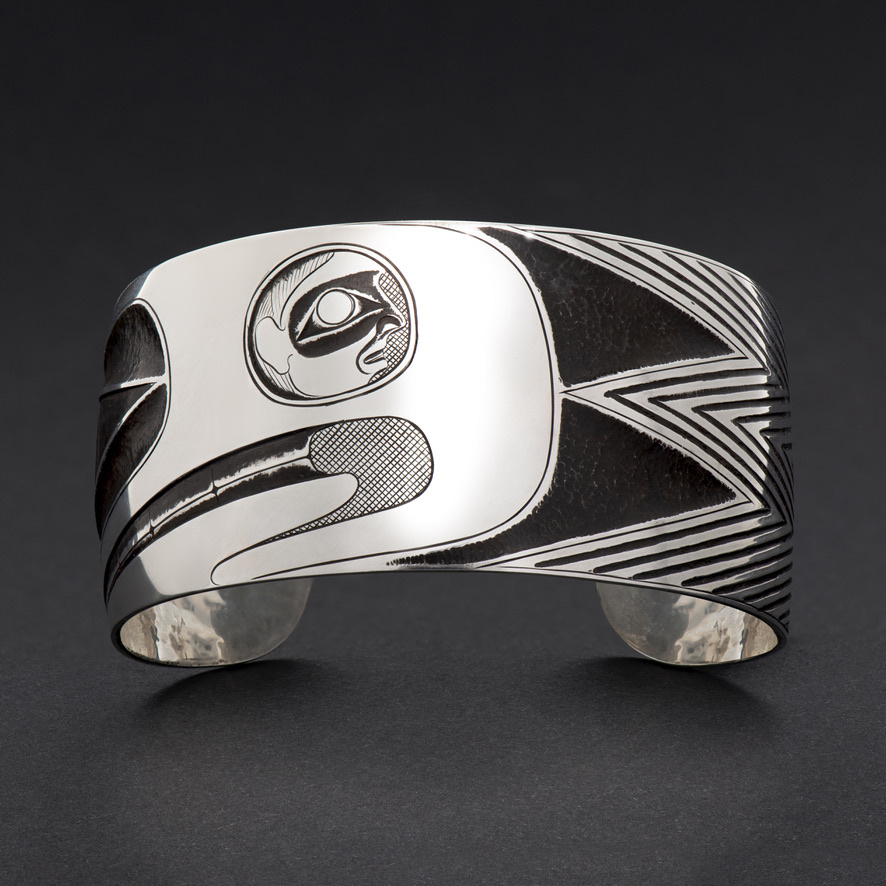Haida Art
- Posted on
- By Cheryl's Trading Post
- 0

Haida art is renowned among Indigenous art styles of the Pacific Northwest. Carvings convey history and lineage, and glimpses of the supernatural world.
Origins
During the time before the Haida, there was only water and darkness inhabited by supernatural beings who were the Haida ancestors. Then two bodies of land arose. Haida Gwaii and the mainland. Raven brought light to the world. He placed the sun, moon and stars in the sky. He freed the first men and women from the shells they’d been trapped in. And he put the salmon and ooligans in the rivers to feed the people. There were boundaries between this world and other worlds. Killer whales had villages beneath the sea, eagles above the sky, and bears and wolves in the forest world. When these beings returned home they took off their coats of feathers or fur or whale skin and were like us.
Haida carving has existed since time immemorial. Stories refer to poles and other carvings that existed in times before humans. Haida learned carving from supernaturals and have developed it over thousands of years. In recent times some artists get inspiration from visions earned in ceremony or from dreams.

Early Haida Art
Indigenous Art has many functions in an oral society. It chronicles history, illustrates spirituality, and records genealogies. The Haida lived in large carved and painted plank houses. Totem poles at the front of houses and carved posts within told the story of the family that lived there. They displayed crests to which stories, songs, names, and lands were connected. Carved masks, rattles and regalia were and are used in spiritual and social ceremonies. Carved bowls are used in potlatches. Bentboxes carved with formline designs have many applications. The great Haida canoes are carved from a single cedar tree and reach over sixty feet long. Women weave spruce root hats, and Chilcat and Ravens Tail blankets. The concept of formline design was well established at least 2500 years ago.
Contact
The first ships contacted the Haida in the 1770’s to trade for sea otters. Half a century later the sea otters were extinct. The smallpox epidemic of 1862 and other epidemics almost wiped the Haida out. The population dropped from over 10,000 to 600 by 1915. Missionaries destroyed or stole the totem poles and discouraged more from being created. The Canadian government banned the Potlatch, and along with it the songs, dances and names, the matrilineal system, the government and the economy. Then the children were taken away to residential schools where they were forbidden to speak their language, and were severely abused. Any remaining cultural practices were driven underground. After sea otters other resources were exploited - marten, land otter, black bear, whaling, salmon canneries, mining, logging.
Commercial Art Production

Haida Art evolved in the period following contact. Demand for carved and painted houses, totem poles and ceremonial art among the Haida was limited due to the oppressions. Artists began producing work for the non-Native market. Argillite model poles and houses, masks and frontlets, and silver and gold jewelry. Charles Edenshaw (1839-1920) was a Haida Chief and a professional artist. He lived through the epidemic or 1862. In his youth he helped his uncle to carve poles. He was one of the first Haida to carve silver and gold. While traditional tattooing became discouraged, people could wear bracelets engraved with their crests and then remove them when necessary. These were also in high demand from the non-Native market. Edenshaw became a renowned artist, known for his argillite carvings, engraved jewelry, and canes with ivory handles and silver ferrules. His wife Isabel wove beautiful spruce root hats and on which he painted Haida designs. His innovations built on the Haida style while adhering to the principles of formline art. Simeon Sdiihlda, a contemporary of Edenshaw was a highly respected old style Chief. His and Edenshaw’s work have often been confused for the other’s. He carved canoes, poles, masks and argillite pieces.

Haida artists require raw materials from their homeland - old growth cedar, cedar bark, spruce root, argillite, shells. The Haida have struggled and fought to preserve these resources from exploiation and destruction. Artists have always held leading positions in Haida society practicing and passing on traditional culture. Robert Davidson (b.1946) is the great, great grandson of Charles Edenshaw. He began carving at 14 years in Old Masset. He later trained with Bill Reid. He raised the first modern totem pole in Haida Gwaii 1969. He initiated the making of Native silk screen prints. He taught at the Gitanmaax School of Northwest Coast Art. Students and teachers of Gitxsan, Tsimshian, Haida, and Kwak’waka’wakw heritage produced poles, masks, and all of the other traditional and commercial art works. The late Bill Reid was a major figure in the revitalization of Haida art. He made the first traditional Haida canoe in modern times. He added repousse and chasing, inlay and lost wax casting to his predecessor’s practice of engraving. He created masterpieces of Native American jewelry. He created great monumental sculptures ‘The Spirit of Haida Gwaii’ and ‘The Raven and the First Man’. Jim Hart, Reg Davidson, Christian White, Don Yeoman, Jay Simeon, Corey Bulpitt, and many other artists are creating art that is contemporary while respecting and adhering to Haida tradition.

Haida art is renowned among Indigenous art styles. Carvings convey history and lineage, and glimpses of the supernatural world. Formline is a visual language - Elements such as the ovoid, trout head, U-shape, S-shape in endless combinations follow definite rules of proportion, balance and movement to create stylized animal forms. Faces and eyes look out from all over the surface of the animal’s bodies. Everything is alive, A view into another world. Designs and concepts have been lost. But many are preserved and more can be regained.





Corey Bulpit, Jay Simeon, Reg Davidson, Lionel Samuels, Calvin Bell.